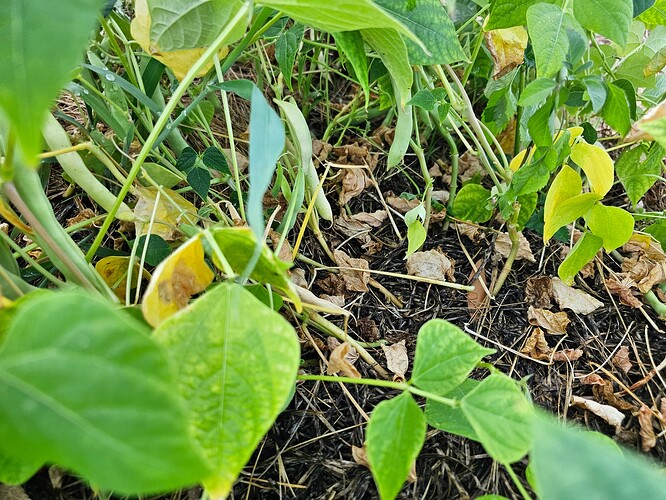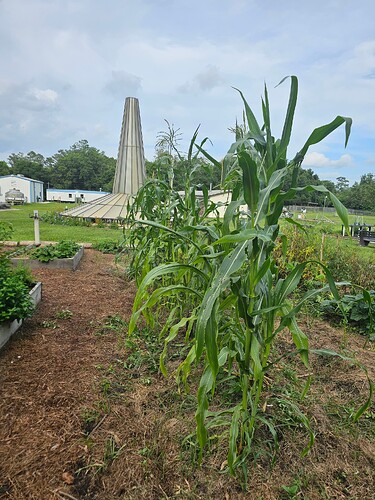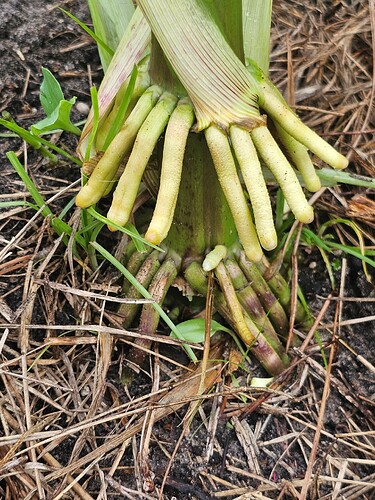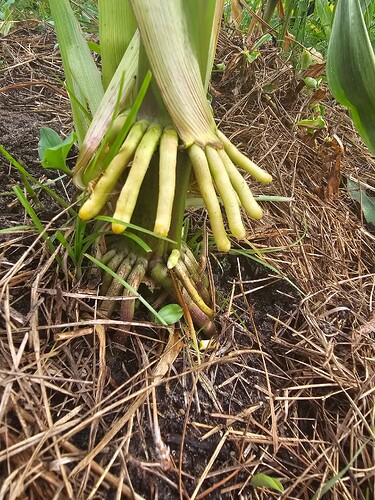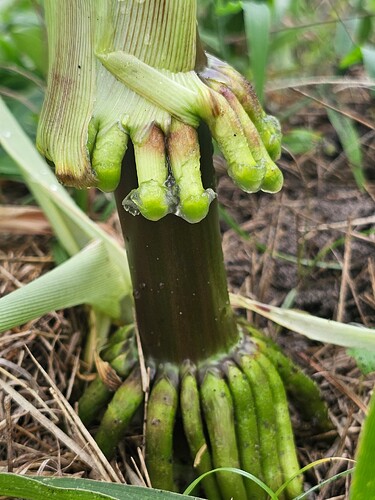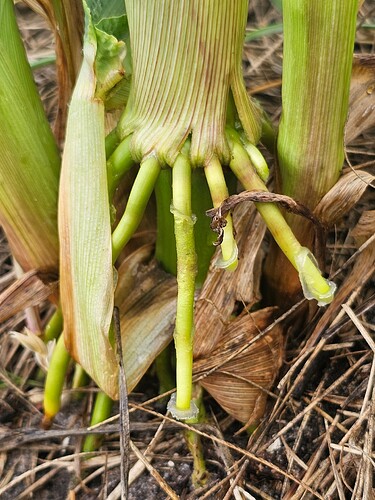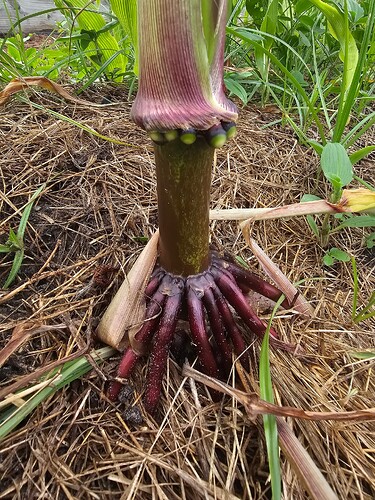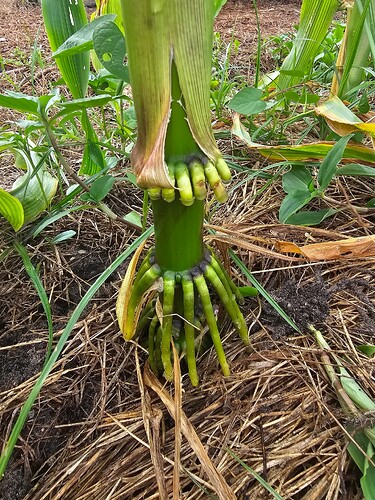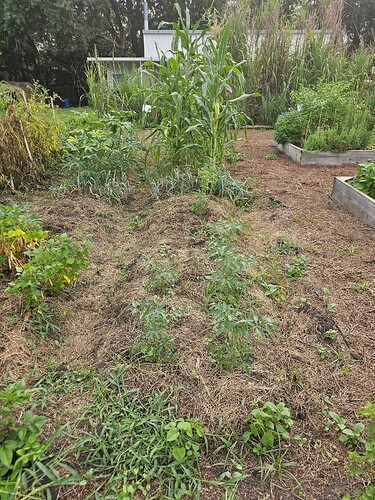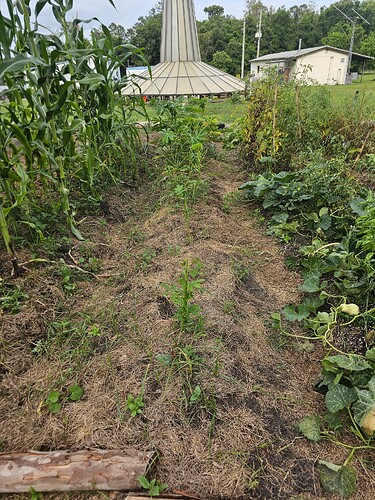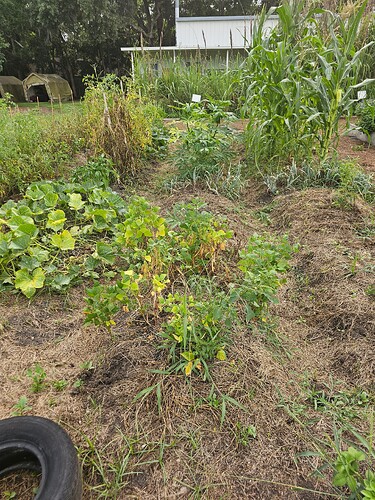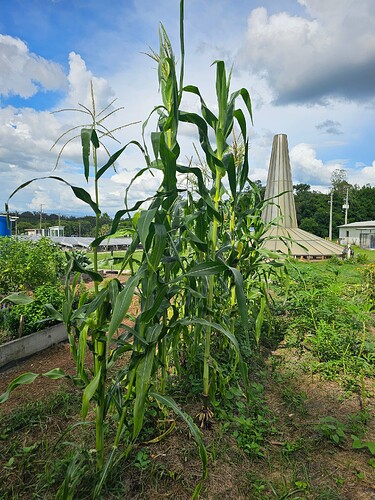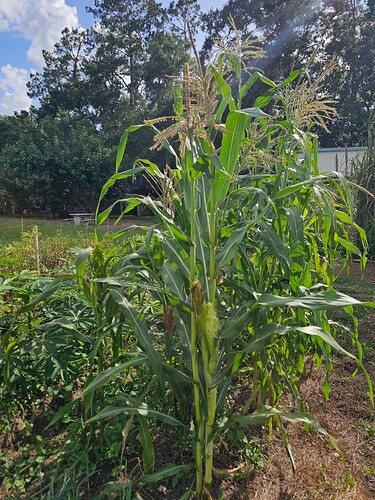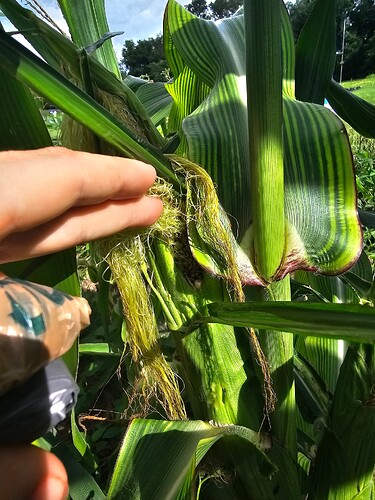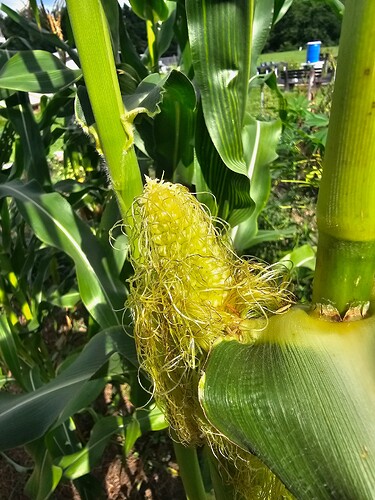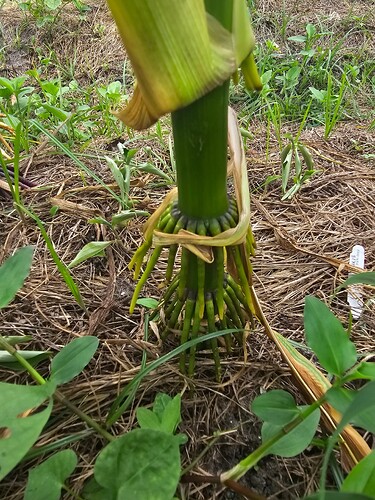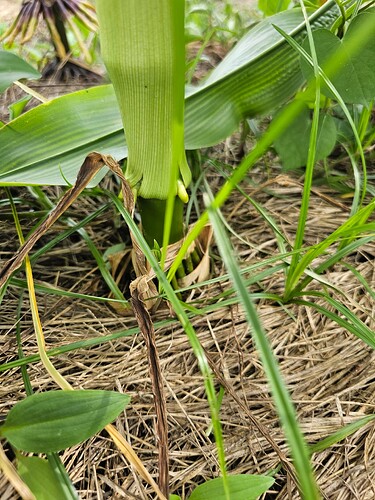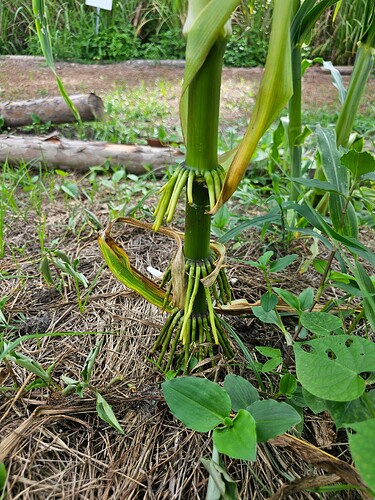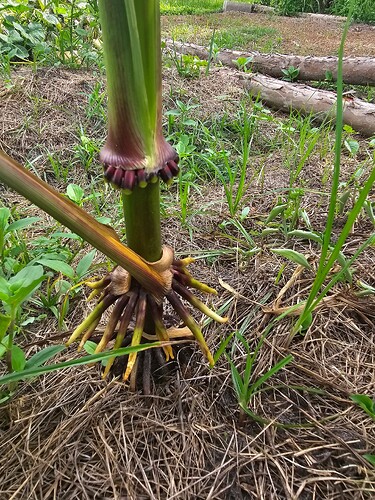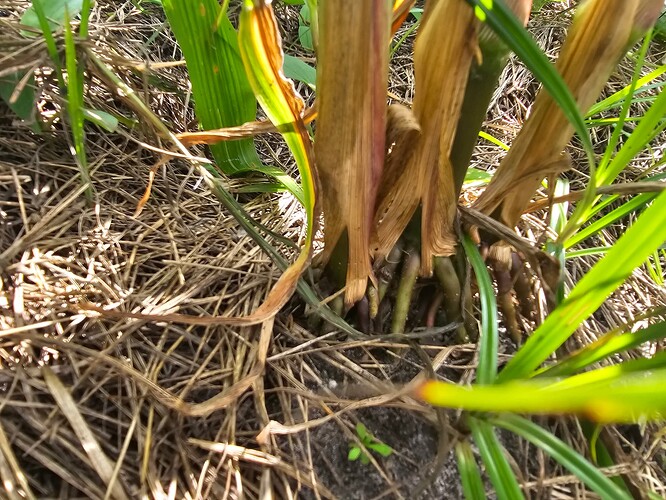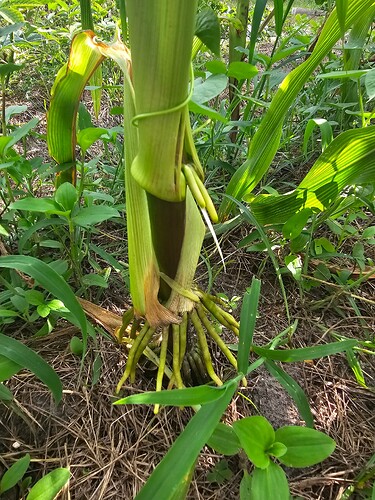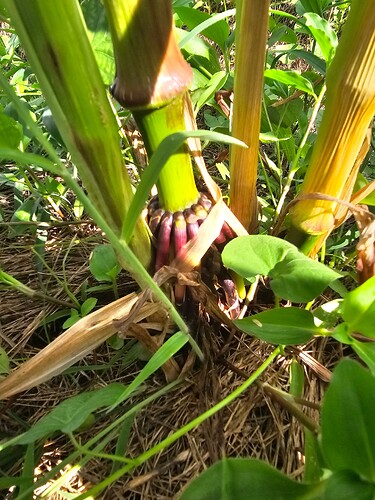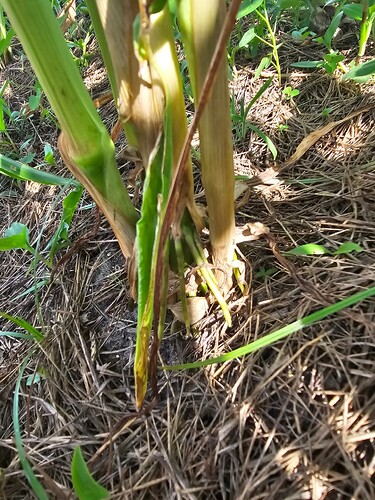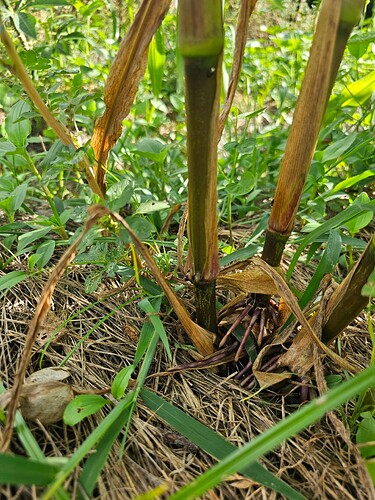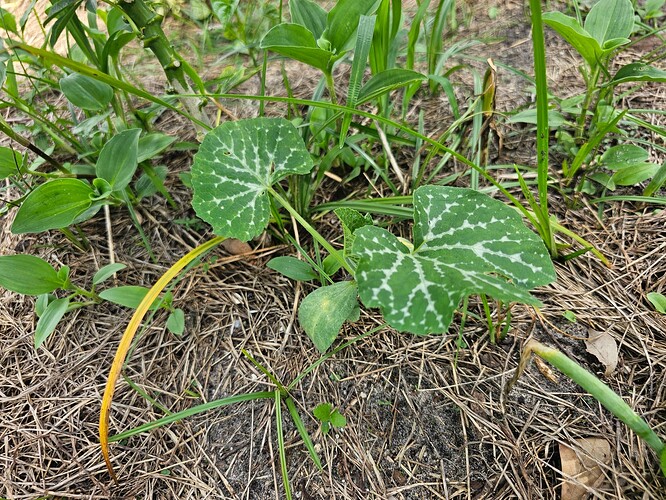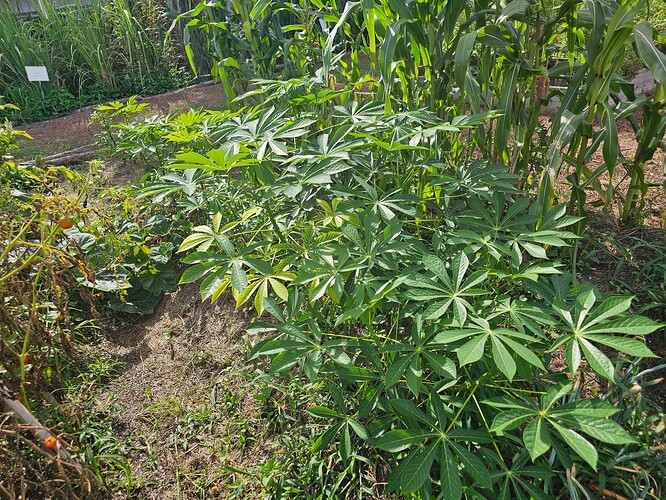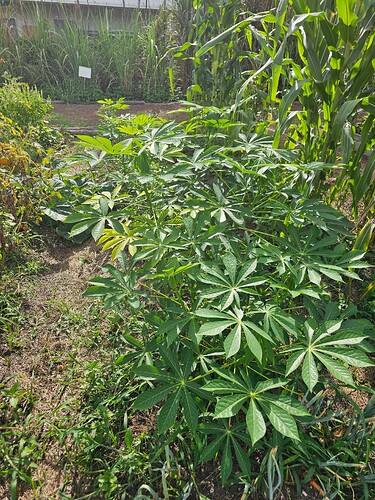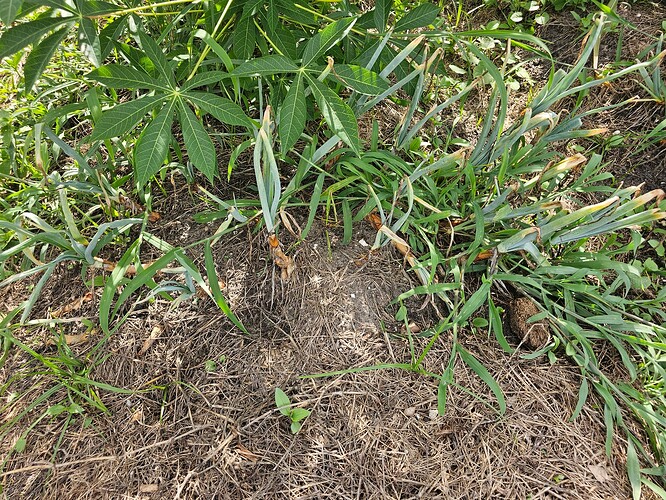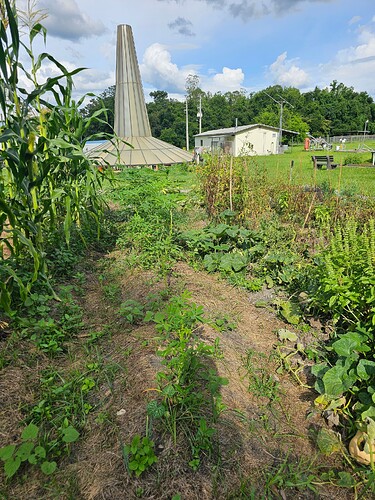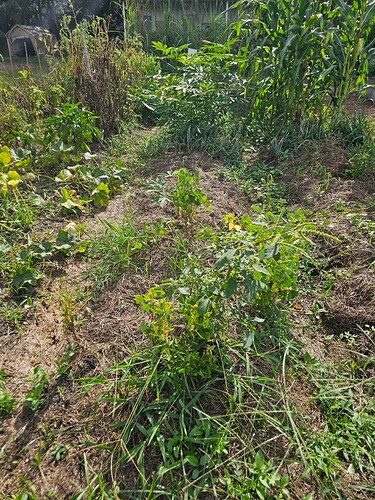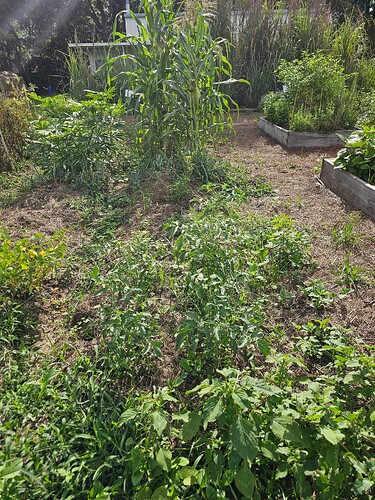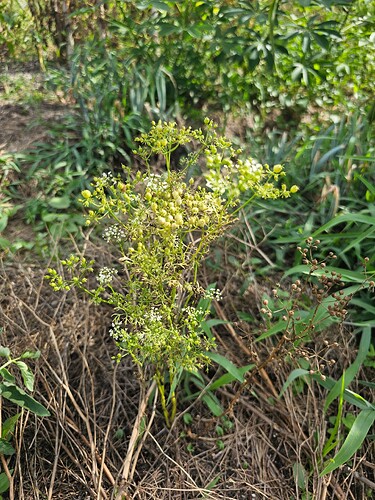Oh, that’s super nice of them! ![]()
It is, and it’s the only way that we can still garden while living inside an apartment. So I am very grateful for them.
Yes! That’s wonderful! How very kind!
4/26/25:
Garden update, we visited the garden on Saturday.
It’s getting hot out this time of year in Gainesville. The last of the nice pleasant weather around here was the last cold front that lasted from 4/7-4/16, it got as cold in the early morning to 50’s. The coldest it was was 48° f. It’s also pretty droughty since that point in time. It hasn’t rained since 4/11.
Nitrogen fixing corn is looking good, and was probably planted late in the season. It looks like it might definitely be knee high by the 4th of July.
Something was eating the top leaves of our cassava clean off the plant.
Husband planted an unknown variety of cassava in the area with the black beans. Acquired it from growing Gainesville a local gardening community into dead and empty cassava planting spots.
The moth visitor that was laying eggs onto our black beans were most likely munching away on those black bean leaves.
Reaching the end of the plant life cycle of our both our pinto/pink and black bean plants. We will harvest the beans soon. Maybe next weekend?
4/28/2025:
Update of the nursery of the plants that will be going into the garden.
And the seed trays the top most plants are of the Tomato cross between ‘Genuwine x Beef steak’, the peppers in the center or of Poblano/Ancho, the bottom is of Everglades Cherry tomato. The seedlings to the left of these are GTS 2024 Purely Promiscuous tomato blend.
Tray of Mirasol/Guajillo peppers, finally starting to sprout.
Tray of Chilaca/Pasilla peppers that still haven’t sprouted yet and one Basil plant sprout from the Sweet Basil Mix.
We were going to plant first tray of seedlings out into the garden this past weekend, but we are waiting for a rainy week to transplant the larger seedlings.
Notes: Moving forward I am trying to keep track of,
Average Temperature in Gainesville
The hot season lasts for 4.5 months, from May 11 to September 26, with an average daily high temperature above 85°F. The hottest month of the year in Gainesville is July, with an average high of 90°F and low of 72°F.
The cool season lasts for 2.7 months, from December 3 to February 24, with an average daily high temperature below 71°F. The coldest month of the year in Gainesville is January, with an average low of 45°F and high of 67°F.
Rainfall: Gainesville experiences a wet season during the summer months, particularly from June to September. Afternoon thunderstorms are common, which can lead to sudden downpours and increased humidity after the rain.
05/04/25:
Corn is growing tall and healthy, despite watering once a week and that they haven’t been fertilized.
Our poblano/ancho pepper mix seedlings were interplanted in the spaces around our corn. It’s supposed to rain later this Sunday, and for most of the week. Forecast also says that this week will be cloudy. Hopefully they survive.
Harvested all of our pinto/pink bean mix, as some of the bean pods were starting to spilt, and most of the pods already turned yellow in color. Short growing season, and days to harvest.
This spot is where we are transplanting our 2024 GTS Promiscous Tomatoes, ‘Genuwine x Beef steak’ cross and the mixture of various lines of Everglades Cherry tomato. The tomato plant starts have been mixed up randomly to help ensure random crossing can occur later in the season.
Cassava growing slowly, maybe they will take off during rainy season? Haven’t noticed of the last cassava cuttings took or not. Will need to check on them next visit.
Black bean mix, still going strong. This might mean that they have a longer season than their pink/pink bean counterparts. Seen new flower buds. These plants have more of a want to climb, pole type trait.
05/11/25:
Corn grew a ton from all of the rainy weather we’ve been having lately!
A lot of Poblano Ancho peppers that survived in the garden from last week’s transplanting. I don’t think that they might not survive, because they seem weak from being started out in our plant start growing area; not enough sun. Next planting make sure we start them and leave them outside directly outside of our porch behind our apartment unit.
Area where the pinto/pink bean mix was harvested. We are thinking of planting out spending else in this space something heat loving that can survive the summer or transplants.
All of the tomato plants that survived a week after being transplanted into the garden. They were a mixture of 2024 GTS Promiscous Tomatoes, ‘Genuwine x Beef steak’ cross and the mixture of various lines of Everglades Cherry tomato. We cannot tell which tomato it is though.
Signs here and there of something nibbling on the cassava leaves. No sign of any pests in the area. Wonder what they could be.
Community Garden Neighbor’s moschata Winter Squash plants look like they want to overtake our planting area, hopefully they don’t cause too much devastation.
Area with the black bean mix plantings, they look like they are just about ready to be harvested. After they are all harvested we will plant something else in this area.
Community Garden Neighbor has another moschata Winter Squash plant that looks like they want to overtake our planting area, hopefully they don’t cause too much devastation.
05/18/25:
The corn has grown overnight it seems. My husband also found one of them already putting out a tassel. I doing recognize them anymore.
It was so hot out, it wasn’t able to check the status of the tomato transplants. Just took these photos and was out of there.
I was able to collect cilantro seeds that were mature, there was a lot, and we still have a lot more to go.
It was decided that we will plant out two Cherokee Purple tomatoes and a tray of Park’s Whopper Improved tomatoes all from Lowe’s out into the garden when we get another rainy weekend. Hopefully by next weekend. These starts have been separated from their siblings and planted into a new plant start tray.
Cassava leaves devoured. We’ve never had any issues from pests eating our cassava plants and their leaves while living in Homestead, FL.
Neighbor’s Moschata winter squash is getting closer to our planting space.
We harvested some of the dried black bean mix pods and will come back for the rest of them in the following visits.
It was decided that we will plant out two Cherokee Purple tomatoes and a tray of Park’s Whopper Improved tomatoes all from Lowe’s out into the garden when we get another rainy weekend. Hopefully by next weekend. These starts have been separated from their siblings and planted into a new plant start tray.
I was able to collect cilantro seeds that were mature, there was a lot, and we still have a lot more to go.
The neighbor’s Moschata winter squash area getting closer to our planting space. They look like they could be a butternut? In this space we are definitely going to transplant the various tomato plenty starts from Lowe’s. Hopefully by next weekend so we can give them a week’s time to get reacclimated to being repotted.
05/20/25:
We didn’t visit the garden, instead this will be an update of the tomato plant starts that will go out into the garden once we get rainy weather.
In this photo, there are tomato plant starts of: Park’s Whopper Improved and Cherokee Purple.
We bought these from Lowe’s, and made sure to buy starts that had more than one plant in each pot to get our money’s worth.
Nice updates. It is good to see someone near me with similar climatic challenges.
Late April and May are typically the hardest months for me and the plants since I don’t have great access to irrigation, the fire ants become super active, eating many corn seeds, and it is hot and dry. Typically, I try to just spend those months harvesting garlic, cool-weather crop seeds like radishes, mustards, winter grains, etc., and resisting the urge to plant much. (It never works)
It’s also great to see people growing cassava there. I tried growing it here, but we don’t get a long enough season, or maybe it has to be planted super early. The defoliated leaves make me think of deer. I think that was actually the problem growing them here at the time—it was before we put up fences.
Where in Gainesville are you? I would be happy to give you some plants/seeds if you’d like. I’m thinking of this red walking onion from EFN that is pretty much indestructible here if I can keep the deer off of it and make sure the weeds don’t overtake it in summer. It’s delicious too and really sizes up in the cooler months.
Feel free to pm me if you want.
Lowell, have you ever thought of trap
cropping (ie, in this case, distracting) your fire ants with potato chips and apple cores? Believe it or not, fire ants were a major issue for me in New Mexico.
I got the idea after watching the 30 some minute documentary on Netflix. If I brought the bags of chips and some apples, I tended to dissuade the scouts and the colony
at large. Food for thought. They love love love
fat, salt, and sweet sugar.
I haven’t tried that intentionally. I finished planting most of my corn already. The last planting was year where we shallow buried fish heads and such from our last excursion on the bay. The ants eat some of it but they mostly go after the maggots. The planting near there has a good germination rate.
The ants are very busy this time of year as they grow the colony size and are producing queens and kings. They’re also busy in the fall. When I plant winter grains, I will pour boiling water on the hills to weaken them. It has helped significantly. I might switch to the chips and apple cores if it is easier. There is a parasitic wasp (very very tiny) that I have seen attack/lay eggs on them when they are above ground. The ants go crazy when it happens, and it greatly disrupts whatever they were doing above ground.
Corn is huge! We can see amazing prop roots, and tassels on two separate plants (but didn’t take any photos during this trip).
There are second generation tomatillos that have been sown directly in the soil. They were already grown out from the Garden Manager and put into the community garden portion of the gardens. We lucked out from is and will have second generation tomatillos to add to the Tomatillo Mix.
Tomato plants have successfully took after being transplanted. The squirrels were digging around the tomato plants.
Cassava is growing back nicely, it looks like the pests that ate a lot of the leaves isn’t bothering the cassava anymore.
There are still some black beans to be picked, and I am not sure what will go into this area when it’s cleared.
There is also a 4 Seminole pumpkins seeds from our Seminole Pumpkin (Year 1) planting from 2024 planted throughout our portion of the garden.
My husband, Daniel, also planted some more Seminole pumpkin seeds in the guerilla style and the side and back of the property to maximize out yield.
At the end of this visit I was able to weed 1/3 of the garden, it was way too hot.
I saw a video from Homegrown Florida, where Seminole pumpkins where growing up a cabbage palm tree. It is the coolest thing ever!
It is in this video on YouTube and it looks amazing!
(It is during the third chapter, at the 2:50 mark.)
After I saw that I wanted to do the same. So now, I planted 6 Seminole Pumpkin seeds in a circle around a cabbage palm next to our apartment building.
Doing some guerilla gardening at our apartment complex. We planted 6 small-fruited Seminole Pumpkin seeds all around the base of this cabbage palm.
I mixed in a good amount of compost to help the pumpkins along, and so that sand, can hold some water. The soil type in this spot is a mixture of white beach sand and a sandy loam. I am watering every day until the seeds sprout.
Hi there,
The fire ants become a problem for us too. Anything in a pot on the ground will become infested with them, and they decided on making a nest in our cassava patch. I usually pour a tea kettle of boiling water on them but can’t do it here, dang.
David the Good grows them in South Alabama. You should try his cultivar- scratch that, we should eventually try his cultivar of cassava lol. I think that his survived the snow day that we had early this year.
Other gardening pests gardeners told us about here in Gainesville are armadillos, squirrels, and fire ants.
My husband says that he saw a moth caterpillar on the cassava. The same kind that he seen eating our cassava back when we where living in Homestead, FL (Zone 10B).
He actually took a photo of the moth while it was on our cassava plants back in Homestead.
We are located in East Gainesville, but will be moving to a different apartment in South Gainesville by the end of the year, which is in the same area as our garden.
Yes, I will definitely send you a PM to talk trading seeds, plants, and ducks sometime. I saw from your profile that you have ducks, and message you a while back about it. We had silver apple yards and Muscovies, and miss them terribly!
We are definitely going to use your potato chips and apple core method. Thank you for the tip!
Two of the six guerilla garden Seminole pumpkins have sprouted at the base of the cabbage palm tree.
6/8/2025:
We visited the garden today, it’s been awhile since our last visit. Reason being was that we were on vacation last weekend.
Everything looks amazing so far.
Our nitrogen fixing corn from MadGardenSeeds have grown super tall, produced their prop roots and what looks like aerial nitrogen fixing fingers. At least that is what I think I’m seeing in the following photos:
The weather was rainy, and humidly hot and we weren’t able to stay long enough for in depth photos of everything.
There was some corn plants with some silks and tassels. It didn’t look like anything pests nor diseases has been hurting our corn plants. They are huge now, and haven’t been fertilized. For the most part, have been surviving on rain water because we are in a consistent rainy season where it rains for a few days every week. We aren’t watering the plants until it gets droughty or if we try starting new seeds directly sown in the garden rows or work with transplants.
I still hope for some second generation tomatillos in the garden for the summer. I collected some aborted tomatillo fruits, and some dried overmature forgotten ones that I squished onto regular sections of the corn portion of the gardening row. I hope that they sprout as the direct seeded salsa verde seeds haven’t sprouted in the two weeks since our last visit.
Tomato transplants are all alive and well have transitioned to the Florida’s hot and wet humid summers. We are still not sure how we are going to stake these plants, but we would like some sort of trellis that isn’t so intricate so our tomato landrace can eventually reliably sprawl on the ground without the use of a trellis.
Dani pulled up most of our cilantro plants, (already pulled), so we can collect our seed for the following growing season. There were lots of stink bug nymphs, spiders and snails hiding amongst the dried cilantro plants. We collected a room of seed as well!
Something is still attacking and eating our cassava plants. Whatever it is it is never giving these plants a break! We don’t think that the plants located at the beginning of this row is going to produce any sizeable edible yucca roots.
Hidden among the cassava plants was the only large fruited Seminole pumpkin that managed to sprout from our year one Seminole pumpkins years back. We hope to utilize the Seminole pumpkins as a ground cover and shade out the weeds for the rest of the summer.
There is more cilantro plants, (already pulled), that have gone to seed in this garden row that was pulled for seed collection.
I pulled up lots of the black bean plants, (already pulled), from this section of the garden that has matured and is ready for seed collection. I left some that looks as though they can still produce more pods for seeds.
We are thinking of pulling up the yellow onions in one of the following garden visits, and replacing the bean, cilantro, and yellow onions portion of the garden rows with lots of sweet potato as ground cover, and some of our home- apartment grown Mirasol/Guajillo pepper and Poblano/Ancho pepper starts during next garden visit.
Next time I hope that I can pull all of the weeds as well.
06/15/2025:
Corn is getting taller, and taller.
Another view of the corn.
Photos of the various corn cobs, one of the corn has grown out of it’s the cob, and another one has a potion of the corn exposed through its cob.
Should we save the seeds from these imperfect corns? The ones that are exposed? And the ones that had a portion exposed through its cob?
Photos of all of our corn’s nitrogen fixing aerial roots. Some of them have more sets than others. The most being two plants with 3 sets. There are many corn plants with two sets, and some with a single set.
Progress of our large fruited Seminole Pumpkin. The lone survivor of 6 seeds that we planted. I hope that it survives as it’s the only plant that we have and we love our pumpkins.
Cassava has grown up and has gotten so large since our last visit.
Another view of the cassava. The sad portion of the cassava section of the garden.
The last of the black beans have gone to seed, and have dried out. We collected the last of the pods after we took the photos of the garden.
Tomatoes are looking beautiful and healthy this far into Florida’s wet, humid, and hot summer.
The last of our cilantro plants that is still in progress of going to seed.









